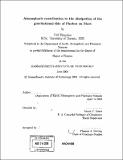Atmospheric contribution to the dissipation of the gravitational tide of Phobos on Mars
Author(s)
Thayalan, Vid
DownloadFull printable version (885.3Kb)
Other Contributors
Massachusetts Institute of Technology. Dept. of Earth, Atmospheric, and Planetary Sciences.
Advisor
Maria T. Zuber.
Terms of use
Metadata
Show full item recordAbstract
Here, we investigate the possibility of a significant atmospheric contribution to the tidal dissipation of the Phobos-Mars system. We apply the classical tidal theory and we find that most of gravitational forcing is projected into the first symmetric Hough mode which has an equivalent depth of about 57 km and it is significantly trapped in the vertical. Therefore, no significant dissipation occurs through the vertical propagation of energy and subsequent breaking of the tidal wave as the wave amplifies with height. Alternatively, from the energy stored in the first trapped mode we estimate that the time scale required for the dissipative mechanisms to account for the total dissipation of the tides is of order 102s. This time scale is unrealistically short, since it would contradict observations of propagating thermal tides in Mars atmosphere. Therefore we conclude that the dissipation of the tidal potential that explains the observed acceleration of Phobos most likely occurs within the solid planet.
Description
Thesis (S.M.)--Massachusetts Institute of Technology, Dept. of Earth, Atmospheric, and Planetary Sciences, 2008. Includes bibliographical references (p. 29).
Date issued
2008Department
Massachusetts Institute of Technology. Department of Earth, Atmospheric, and Planetary SciencesPublisher
Massachusetts Institute of Technology
Keywords
Earth, Atmospheric, and Planetary Sciences.